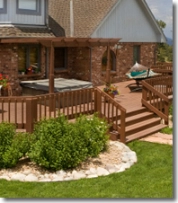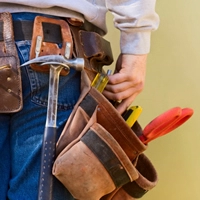Deck Repair: Maintenance Steps to Ensure Safety and Avoid Expense

Now is the time for all good men and women to come to the aid of their neglected decks! Like many home maintenance efforts, simple timely repairs can often prevent more difficult, time-consuming, and expensive ones later. Like some other maintenance work, deck repairs can also be a matter of safety, such as when you secure a loose railing or replace a rotten stair tread. Fortunately, the basic carpentry skills and tools required make this project within reach of most homeowners. Giving the deck a thorough cleaning is the best place to start. Next, set nails and sand the rough or splintering deck. Use a Cat's-Paw-type nail puller and pry bar to remove damaged decking. Also, replace treads that are rotten or otherwise damaged. Secure posts that are inadequately nailed or screwed in place. When all cleaning and repairs are complete, treat your deck to a coat of water-repellent stain. Even pressure-treated wood requires such annual protection.
Maintenance Tips
- Before You Begin: Every spring, make a careful inspection of your deck to determine which repairs may be required. Are railings, especially those around stairs, solidly fastened? Is the surface splintered or covered with algae? Does any decking or framing need to be replaced? Make a list of all the work to be done and the materials needed. On a nice sunny weekend, gather or rent the necessary tools, including safety gear, such as goggles and kneepads.
- Rent a Pressure Washer for the Day: You'll have so much fun cleaning the deck that you won't want to stop there. Walks, driveway, car ... but please, not the dog!
- Scrub Deck: Start with a good cleaning. Scrub the decking surface until it's clean and free of slippery green slime (algae). Use a garden hose with a power nozzle, and an old knife or similar tool to get out dirt and debris from between the cracks. Use one of the many commercial deck cleaners available and follow the instructions on the label. Deck restorers can be used in place of cleaners to restore the original color of the wood. They are sprayed and/or scrubbed on, and then hosed off,
- Tip: Wear goggles when pressure-washing or scrubbing with chemical cleaners or restorers. Also if you're working on your knees, use kneepads; or cushion your knees with a carpet scrap or the like.

- Secure Nails: As the wood expands and contracts, nails may "pop" above the surface, presenting a tripping hazard. Use a hammer and nail set to drive them below the surface. Do this, too, if you plan to sand (next step). Raised nail heads will quickly shred your $2 sanding belt.
- Tip: No nail set? Want a safer method? Lay flat a 12d or 16d common nail with its head over the nail to be set. Holding the nail (with your fingers a safe distance away), strike a firm blow with a hammer.
- Sand Wood: Sand rough surfaces. Pay special attention to splintered areas and to handrails. Use a power sander, such as the belt sander shown here, with 80-grit paper. Large shard-like splinters follow the grain and sanding out may cut too deeply. Use a hammer and chisel to cut these spears off at the base and sand and rough edges.
- Remove Damaged Wood: Cut out a section of a damaged board rather than replace the entire board. Use a jigsaw to crosscut the board adjacent to a joist. Cut a 2 x 4 block; bore clearance holes for two 3-in. no. 8 exterior screws; and secure it to the joist at the repair location. Cut a board to fit; and secure it to the nailer and any joists with screws.
- Tip: Very often damage is limited to the upper surface. If you can, just remove a board with a nail puller and flip it over.
- Secure Boards: Use 3-in. no. 8 exterior wood screws and a drill-driver to secure 2x decking. Drill clearance holes (equal to screw diameter) through the decking only when attempting to draw down warped or cupped boards, and at the ends of boards to prevent splitting. If available, use the drill's torque setting to prevent snapping off screws due to too much force.
- Repair Stairs: Cut through the middle of any damaged stair treads to remove it. Measure and cut new board. Treads may be set into a dado or nailed to a cleat attached to the side of a stair stringer. If there is a notched stringer in the center of a wider set of steps, use a nail puller. (Prying or banging may split the vulnerable stringer.)
- Tip: Do not use a circular saw to make this unsupported cut. Binding is inevitable and will cause a dangerous kickback.
- Replace Tread: Cut a replacement tread and insert it into the dados in the stringers. If you have a pipe clamp, use it to draw the stringers tight against the edges of the tread before fastening it with three 2-1/2-in. no. 8 exterior decking screws. Do the same if cleats are employed, but make sure they are sound and securely screwed to the stringers.
- Tip: Construction adhesive, available in tubes for caulking guns, remains flexible and makes any critical connection much more reliable.
- Secure Railing: Nails and screws are inadequate to secure railing posts. If your older deck was built this way, bring it up to code. Use a spade drill bit and bore clearance holes through the post and perimeter joists and install two 5/16- or 3/8-in. through-bolts (length to suit, and with washers of both ends) at each post location, especially at any steps.

Tools and Materials
- Bucket and stiff scrub brush
- Hose and nozzle
- Kneepads and goggles
- Deck cleaner or restorer
- Pressure washer
- Nail hammer and nail set
- Wood chisel
- Power sander (or hand sanding block)
- 80-grit sandpaper, sanding belts
- Cats-Paw nail puller
- Flat pry bar
- 12d galvanized common nails or 3-in. (min) #8 exterior screws
- Drill-driver with a magnetic bit holder and #2 Philips bits
- Pipe or bar clamp (optional)
- Extension cord, if required
- Hex bolts, washers, and nuts
- Wrenches
 Click to call
Click to call


